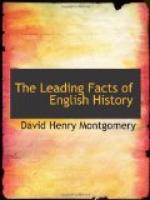The weapons of this class of soldiers consisted of a lance and a double-edged sword. The foot soldiers wore little or no armor and fought principally with long bows. In case of need, the King could probably muster about ten thousand knights, or armed horsemen, and a much larger force of foot soldiers. Under the Norman kings the principal wars were insurrections against William I, the various revolts of the barons, and the civil war under Stephen.
153. Knighthood.[1]
Candidates for knighthood were usually obliged to pass through a long course of training under the care of some distinguished noble. The candidate served first as a page, or attendant in the house; then, as a squire or attendant, he followed his master to the wars. After seven years in this capacity, he prepared himself for receiving the honors of knighthood by spending several days in a church, engaged in solemn religious rites, fasting, and prayer.
[1] Knighthood: Originally the knight was a youth or attendant. Later, the word came to mean an armed horse soldier or cavalier who had received his weapons and title in a solemn manner. As a rule, only the wealthy and noble could afford the expense of a horse and armor; for this reason chivalry, or knighthood, came to be closely connected with the idea of aristocracy. In some cases soldiers were made knights on the battlefield as a reward for valor.
The young man, in the presence of his friends and kindred, then made oath to be loyal to the King, to defend religion, and to be the champion of every lady in danger or distress. Next, a high-born dame or great warrior buckled on his spurs, and girded the sword, which he priest had blessed, to his side. This done, he knelt to the prince or noble who was to perform the final ceremony. The prince struck him lightly on the shoulder with the flat of the sword, saying: “In the name of God, St. Michael,[2] and St. George [the patron saint of England], I dub thee knight. Be brave, hardy, and loyal.”
[2] St. Michael, as representative of the triumphant power of good over evil.
Then the young cavalier leaped into the saddle and galloped up and down, brandishing his weapon in token of strength and skill. In case a knight proved false to his oaths, he was publicly degraded. His spurs were taken from him, his shield was reversed, his armor broken to pieces, and a sermon preached upon him in the neighboring church, proclaiming him dead to the order.
IV. Literature, Learning, and Art
154. Education; Use of Seals or Stamps.
The leaning of this period was confined almost wholly to the clergy. Whatever schools existed were connected with the monasteries and nunneries. Oxford had begun to be regarded as a seat of leaning (1120). The instruction was given by priests, though some noted Jewish scholars may have had pupils there. Very few books were written during this period. Generally speaking, the nobility considered fighting the great business of life and cared nothing for education. They thought that reading and writing were beneath their dignity, and left such accomplishments to monks, priests, and lawyers. For this reason seals or stamps having some device or signature engraved on them came to be used on all papers of importance.




